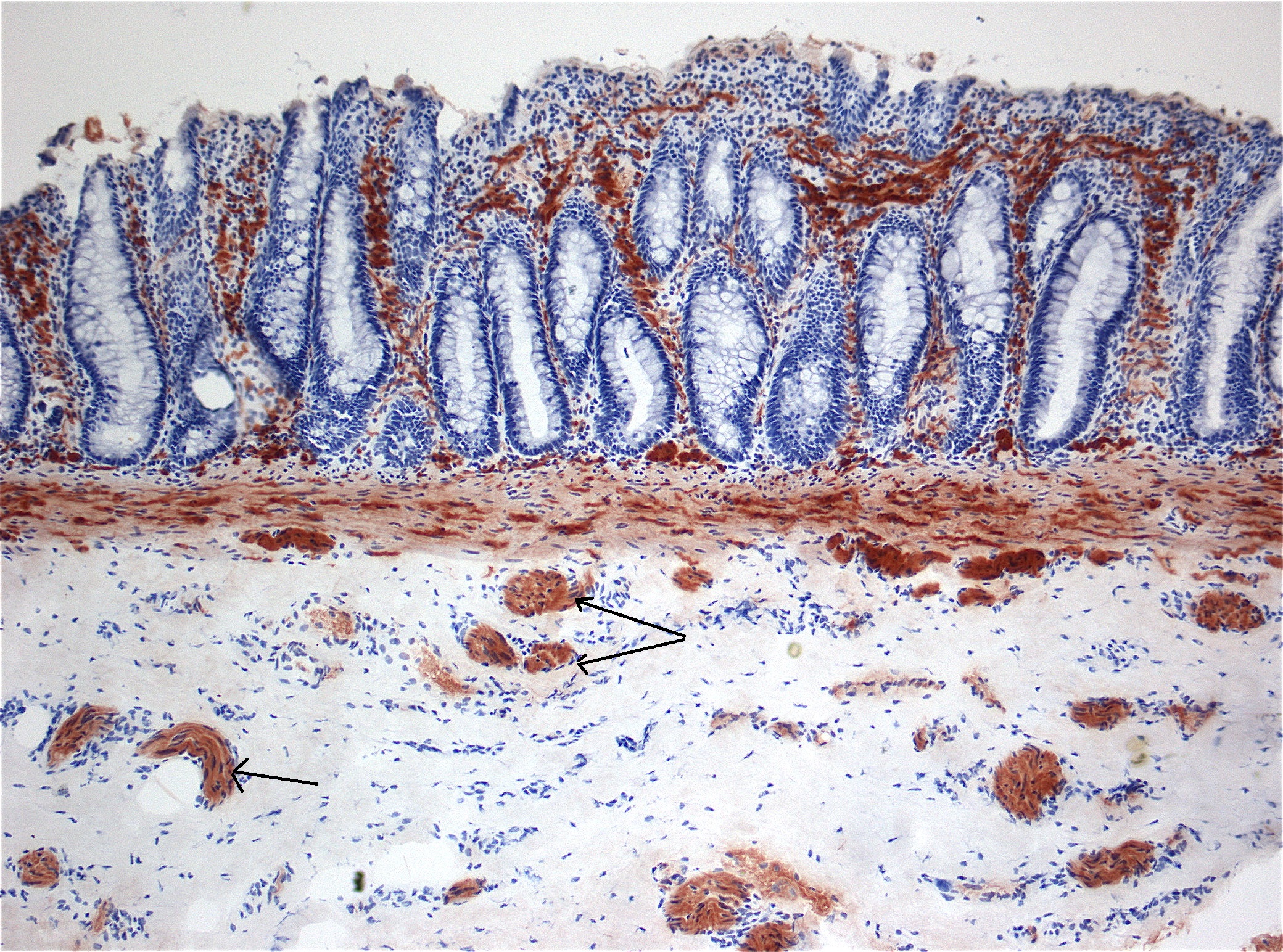Hirschsprung's disease pathophysiology: Difference between revisions
Jump to navigation
Jump to search
Ahmed Younes (talk | contribs) No edit summary |
Usama Talib (talk | contribs) No edit summary |
||
| Line 1: | Line 1: | ||
__NOTOC__ | __NOTOC__ | ||
{{Hirschsprung's disease}} | {{Hirschsprung's disease}} | ||
{{CMG}} | {{CMG}}; {{AE}}{{AY}} {{ADG}} | ||
==Overview== | ==Overview== | ||
Revision as of 15:49, 16 June 2017
|
Hirschsprung's disease Microchapters |
|
Diagnosis |
|---|
|
Treatment |
|
Case Studies |
|
Hirschsprung's disease pathophysiology On the Web |
|
American Roentgen Ray Society Images of Hirschsprung's disease pathophysiology |
|
Risk calculators and risk factors for Hirschsprung's disease pathophysiology |
Editor-In-Chief: C. Michael Gibson, M.S., M.D. [2]; Associate Editor(s)-in-Chief: Ahmed Younes M.B.B.CH [3] Aditya Ganti M.B.B.S. [4]
Overview
Hirschsprung’s disease is a congenital disorder of the colon in which certain nerve cells, known as ganglion cells, are absent, causing chronic constipation.
Pathophysiology
Genetics
- In 2002 and according to a new research, the interaction between two proteins encoded by two variant genes caused Hirschsprung’s.
- The RET proto-oncogene on chromosome 10 was identified one of the genes involved, and it was determined that dominant mutations may occur within this gene leading to a loss of function for the protein it encoded.[1]
- The protein with which RET has to interact in order for Hirschsprung’s disease to develop is termed EDNRB, and is encoded by the gene EDNRB located on chromosome 13.
- Six other genes were discovered to be associated with Hirschsprung’s. According to the study, these genes are GDNF on chromosome 5, EDN3 on chromosome 20, SOX10 on chromosome 22, ECE1 on chromosome 1, NTN on chromosome 19, and SIP1 on chromosome 2.
- Scientists concluded that the mode of inheritance for Hirschsprung’s is oligogenic inheritance. This means that two mutated genes interact to cause a disorder. Variations in RET and EDNRB have to coexist in order for a child to get Hirschsprung’s.[2]
- However, although six other genes were shown to have an effect on Hirschsprung’s, the researchers were unable to determine how they interacted with RET and EDNRB. Thus, the specifics of the origins of the disease are still not completely known.
- More recently, syndromic cases of Hischprung's disease (that is, associated with other defects of the autonomic nervous system) were shown to be caused by mutations in the homeobox gene PHOX2B.
- RET codes for proteins that help the neural crest cells (which become ganglion cells) move through the digestive tract during the development of the embryo.
- EDNRB codes for proteins to actually connect these nerve cells to the digestive tract. This means that the absence of certain nerve fibers in the colon could be directly related to these two genes mutating so the wrong proteins are produced.
- Research published in June of 2004 suggests that there are actually ten genes associated with Hirschsprung’s disease. Also, new research suggests that mutations in genomic sequences involved in regulating EDNRB have a bigger impact on Hirschsprung’s disease than previously thought.
- Dr. Bob Sawin of Seattle’s Children's Hospital notes that it is generally accepted in the scientific community that the gene RET is the most important gene when looking for the genetic cause of Hirschsprung’s disease. RET can mutate in many ways and is associated with Down syndrome. Since Down Syndrome is comorbid in two percent of Hirschsprung’s cases, there is a likelihood that RET is involved heavily in both Hirschprung's disease and Down Syndrome.[3]
- RET is also associated with thyroid cancer and neuroblastoma. Both of these disorders have also been observed in Hirschsprung’s patients with greater frequency than in the general population.
- One function that RET controls is the travel of the neural crest cells through the intestines in the developing fetus. When RET mutations cause Hirschsprung’s disease, the cells start traveling through the colon, only to be stopped once the mutation occurs. The earlier the mutation of RET occurs in Hirschsprung’s disease, the more severe the disorder becomes.
- While researchers remain uncertain of the exact genetic cause of Hirschsprung’s disease, Dr. Sawin notes that in familial cases, (in which families have multiple affected patients) Hirschsprung’s disease exhibits autosomal dominant transmission, with the gene RET being dominant. However, in sporadic cases, Sawin notes that there has been no inheritance pattern identified.
- Treating Hirschsprung’s is much easier than determining the genetic causes of this disorder. The only way to treat Hirschsprung’s disease is through surgery (National Digestive Diseases Information Clearinghouse). If Hirschsprung’s goes untreated, the patient can develop enterocolitis, the k of the small intestine and the colon. This was the cause of death of the two boys that Harald Hirschsprung observed. Surgery is now used to remove the non-functioning portion of the bowel in order to restore bowel function.
- Hirschsprung's disease, hypoganglionosis, gut dysmotility, gut transit disorders and intussusception have been recorded with the dominantly inherited neurovisceral porphyrias (acute intermittent porphyria, hereditary coproporphyria, variegate porphyria).
- Children may require enzyme or DNA testing for these disorders as they may not produce or excrete porphyrins prepuberty.
Microscopic picture
- Biopsy shows absence of ganglionic cells.
- Presence of hypertrophied nerve trunks using in the lamina propria on using acetylcholinesterase staining.[4]
- Calretinin staining shows decreased immunofluorescence.
Video: Histopathological Findings
{{#ev:youtube|v3mfl0l6Tdo}}
References
- ↑ "Thieme E-Journals - European Journal of Pediatric Surgery / Abstract".
- ↑ "A gene for Hirschsprung disease (megacolon) in the pericentromeric region of human chromosome 10 - Nature Genetics".
- ↑ Elhalaby EA, Teitelbaum DH, Coran AG, Heidelberger KP (1995). "Enterocolitis associated with Hirschsprung's disease: a clinical histopathological correlative study". J. Pediatr. Surg. 30 (7): 1023–6, discussion 1026–7. PMID 7472925.
- ↑ Worman and Ganiats 1995, Am Fam Physician 51, 487-494 [1]
